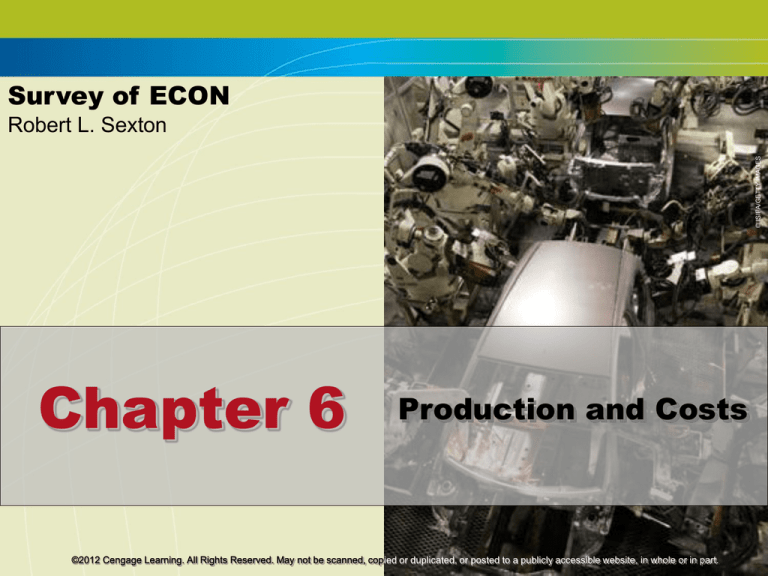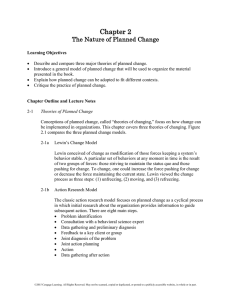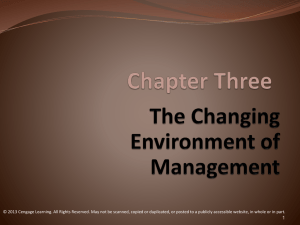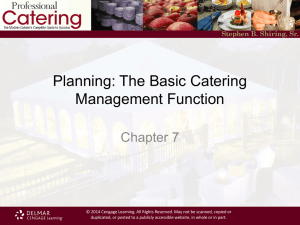
Survey of ECON
© ISIFA/GETTY IMAGES
Robert L. Sexton
Chapter 6
Production and Costs
1
©2012 Cengage Learning. All Rights Reserved. May not be scanned, copied or duplicated, or posted to a publicly accessible website, in whole or in part.
Chapter 6 Sections
– Firms and Profits: Total Revenues
Minus Total Costs
– Production in the Short Run
– Costs in the Short Run
– The Shape of the Short-Run Cost
Curves
– Cost Curves: Short-Run versus
Long-Run
2
©2012 Cengage Learning. All Rights Reserved. May not be scanned, copied or duplicated, or posted to a publicly accessible website, in whole or in part.
Firms and Profits: Total
Revenues Minus Total Costs
3
©2012 Cengage Learning. All Rights Reserved. May not be scanned, copied or duplicated, or posted to a publicly accessible website, in whole or in part.
Section 1
SECTION 1 QUESTIONS
4
©2012 Cengage Learning. All Rights Reserved. May not be scanned, copied or duplicated, or posted to a publicly accessible website, in whole or in part.
Firms and Profits
• A firm’s costs are a key determinant in
pricing and production decisions.
• But what exactly makes up a firm’s cost
of production?
• Let’s begin by looking at the two distinct
components of a firm’s total cost: explicit
costs and implicit costs.
5
©2012 Cengage Learning. All Rights Reserved. May not be scanned, copied or duplicated, or posted to a publicly accessible website, in whole or in part.
Explicit Costs
• Explicit costs are input costs that
require a monetary payment.
• They are out-of-pocket expenses, such
as wages, which are relatively easy to
measure by the money spent on the
resources used.
6
©2012 Cengage Learning. All Rights Reserved. May not be scanned, copied or duplicated, or posted to a publicly accessible website, in whole or in part.
Implicit Costs
© ERLEND KVALSVIK/ISTOCKPHOTO.COM
• Implicit costs do not
represent an explicit
outlay of money, but
they are still real,
representing the
implicit opportunity
costs of alternatives
that must be forgone.
7
©2012 Cengage Learning. All Rights Reserved. May not be scanned, copied or duplicated, or posted to a publicly accessible website, in whole or in part.
Implicit Costs:
Example
• Example: A typical farmer or small
business owner may perform work without
receiving formal wages, but the value of the
alternative earnings forgone represents an
implicit opportunity cost to the individual.
8
©2012 Cengage Learning. All Rights Reserved. May not be scanned, copied or duplicated, or posted to a publicly accessible website, in whole or in part.
Implicit Costs
• Whenever we talk about costs explicit or
implicitwe are talking about opportunity
costs.
9
©2012 Cengage Learning. All Rights Reserved. May not be scanned, copied or duplicated, or posted to a publicly accessible website, in whole or in part.
Profits
• Economists generally assume that
the ultimate goal of every firm is to
maximize profits.
• In other words, firms try to maximize the
difference between what they receive for
their goods and services— their total
revenue—and what they give up for their
inputs—their total costs (explicit and
implicit).
10
©2012 Cengage Learning. All Rights Reserved. May not be scanned, copied or duplicated, or posted to a publicly accessible website, in whole or in part.
Accounting Profits and
Economic Profits
ACCOUNTING PROFITS
total revenues minus total explicit
costs.
ECONOMIC PROFITS
total revenues minus all explicit and
implicit costs.
11
©2012 Cengage Learning. All Rights Reserved. May not be scanned, copied or duplicated, or posted to a publicly accessible website, in whole or in part.
Exhibit 6.1: Accounting Profits versus
Economic Profits
12
©2012 Cengage Learning. All Rights Reserved. May not be scanned, copied or duplicated, or posted to a publicly accessible website, in whole or in part.
A Zero Economic Profit is
a Normal Profit
• Economists consider a zero economic
profit a normal profit because it means
that the firm is covering both implicit and
explicit costs—the total opportunity cost
of its resources.
• This is clearly different from making a
zero accounting profit, when revenues
would not cover the implicit costs.
13
©2012 Cengage Learning. All Rights Reserved. May not be scanned, copied or duplicated, or posted to a publicly accessible website, in whole or in part.
Sunk Costs
SUNK COSTS
costs that have already been incurred
and cannot be recovered.
Sunk costs are
irrelevant for any
future action.
14
©2012 Cengage Learning. All Rights Reserved. May not be scanned, copied or duplicated, or posted to a publicly accessible website, in whole or in part.
Section 1
15
©2012 Cengage Learning. All Rights Reserved. May not be scanned, copied or duplicated, or posted to a publicly accessible website, in whole or in part.
Production in the Short Run
16
©2012 Cengage Learning. All Rights Reserved. May not be scanned, copied or duplicated, or posted to a publicly accessible website, in whole or in part.
Section 2
SECTION 2 QUESTIONS
17
©2012 Cengage Learning. All Rights Reserved. May not be scanned, copied or duplicated, or posted to a publicly accessible website, in whole or in part.
The Short Run Versus the
Long Run
• Since it takes more time to vary some
inputs than others, we must distinguish
between the short run and the long run.
18
©2012 Cengage Learning. All Rights Reserved. May not be scanned, copied or duplicated, or posted to a publicly accessible website, in whole or in part.
The Short Run versus the
Long Run
• The short run is defined as a period too
brief for some inputs to be varied.
• In the short run, the inputs that do not
change with output are called fixed inputs.
19
©2012 Cengage Learning. All Rights Reserved. May not be scanned, copied or duplicated, or posted to a publicly accessible website, in whole or in part.
The Short Run versus the
Long Run
• The long run is a period of time in which
the firm can adjust all inputs. In the long
run, all inputs to the firm are variable and
will change as output changes.
• The long run can vary considerably in
length from industry to industry.
20
©2012 Cengage Learning. All Rights Reserved. May not be scanned, copied or duplicated, or posted to a publicly accessible website, in whole or in part.
Production in the Short
Run
• Production function is the relationship
between the quantity of inputs and the
quantity of outputs.
• Total output (Q) is the total amount of
output of a good produced by the firm.
21
©2012 Cengage Learning. All Rights Reserved. May not be scanned, copied or duplicated, or posted to a publicly accessible website, in whole or in part.
Production in the Short
Run
• Total output will start at a low level and
increase—perhaps rapidly at first, and then more
slowly—as the amount of the variable input
increases.
• It will continue to increase until the quantity of the
variable input becomes so large in relation to the
quantity of others that further increases in output
become more and more difficult or even
impossible.
22
©2012 Cengage Learning. All Rights Reserved. May not be scanned, copied or duplicated, or posted to a publicly accessible website, in whole or in part.
Exhibit 6.2: Moe’s Production Function
with One Variable, Labor
23
©2012 Cengage Learning. All Rights Reserved. May not be scanned, copied or duplicated, or posted to a publicly accessible website, in whole or in part.
Rising Marginal Product
• The marginal product (MP) of any
single input is defined as the change in
total product resulting from a small
change in the amount of that input used.
• Marginal product first rises as the result
of more effective use of fixed inputs, and
then falls.
24
©2012 Cengage Learning. All Rights Reserved. May not be scanned, copied or duplicated, or posted to a publicly accessible website, in whole or in part.
Exhibit 6.3: Total Output and
Marginal Product
25
©2012 Cengage Learning. All Rights Reserved. May not be scanned, copied or duplicated, or posted to a publicly accessible website, in whole or in part.
Exhibit 6.3: Total Output and
Marginal Product
26
©2012 Cengage Learning. All Rights Reserved. May not be scanned, copied or duplicated, or posted to a publicly accessible website, in whole or in part.
Diminishing Marginal
Product
• As the amount of a variable input is increased,
the amount of other (fixed) inputs being held
constant, a point ultimately will be reached
beyond which marginal product will decline.
• Diminishing marginal product stems from the
crowding of the fixed input with more and more
of the variable input.
27
©2012 Cengage Learning. All Rights Reserved. May not be scanned, copied or duplicated, or posted to a publicly accessible website, in whole or in part.
Diminishing Marginal
Product
• A firm never knowingly allows itself to reach
the point at which the marginal product
becomes negative, the situation in which
the use of additional variable input units
actually reduces total output.
• In such a situation, there are so many units
of the variable input (inputs with positive
opportunity costs) that efficient use of the
fixed input units is impaired.
28
©2012 Cengage Learning. All Rights Reserved. May not be scanned, copied or duplicated, or posted to a publicly accessible website, in whole or in part.
Section 2
29
©2012 Cengage Learning. All Rights Reserved. May not be scanned, copied or duplicated, or posted to a publicly accessible website, in whole or in part.
Costs in the Short Run
30
©2012 Cengage Learning. All Rights Reserved. May not be scanned, copied or duplicated, or posted to a publicly accessible website, in whole or in part.
Section 3
SECTION 3 QUESTIONS
31
©2012 Cengage Learning. All Rights Reserved. May not be scanned, copied or duplicated, or posted to a publicly accessible website, in whole or in part.
Costs in the Short Run
• The short-run total costs of a business
fall into two distinct categories:
– Fixed costs
– Variable costs
32
©2012 Cengage Learning. All Rights Reserved. May not be scanned, copied or duplicated, or posted to a publicly accessible website, in whole or in part.
Fixed Costs, Variable Costs,
and Total Costs
• Fixed costs are costs that do not vary with the level
of output.
– Examples: the rent on buildings or equipment that
is fixed for some period of time, as well as
insurance premiums and property taxes.
• Fixed costs have to be paid even if no output is
produced.
• In the short run, fixed costs cannot be avoided.
33
©2012 Cengage Learning. All Rights Reserved. May not be scanned, copied or duplicated, or posted to a publicly accessible website, in whole or in part.
Fixed Costs, Variable Costs,
and Total Costs
• The sum of the firm’s fixed costs is called
its total fixed cost (TFC).
• Costs that are not fixed are called
variable costs. Variable costs vary with
the level of output.
– Examples: the expenditures on wages and
raw materials
34
©2012 Cengage Learning. All Rights Reserved. May not be scanned, copied or duplicated, or posted to a publicly accessible website, in whole or in part.
Fixed Costs, Variable Costs,
and Total Costs
• The sum of the firm’s variable costs is
called its total variable cost (TVC).
• The sum of the firm’s total fixed costs and
total variable costs is called its total cost
(TC).
35
©2012 Cengage Learning. All Rights Reserved. May not be scanned, copied or duplicated, or posted to a publicly accessible website, in whole or in part.
Average Total Costs
• Sometimes we find it convenient to
discuss costs on a per-unit-of-output,
or average, basis.
AVERAGE TOTAL COST (ATC)
a per-unit cost of operation; total cost
divided by output
36
©2012 Cengage Learning. All Rights Reserved. May not be scanned, copied or duplicated, or posted to a publicly accessible website, in whole or in part.
Average Fixed Cost and
Average Total Cost
• Average fixed cost (AFC) equals total
fixed cost divided by the level of output
produced.
• Average variable cost (AVC) equals total
variable cost divided by the level of output
produced.
37
©2012 Cengage Learning. All Rights Reserved. May not be scanned, copied or duplicated, or posted to a publicly accessible website, in whole or in part.
Marginal Cost
• The most important single cost concept
is marginal cost.
• Marginal cost (MC) shows the change
in total costs associated with a change
in output by one unit, or the costs of
producing one more unit of output.
38
©2012 Cengage Learning. All Rights Reserved. May not be scanned, copied or duplicated, or posted to a publicly accessible website, in whole or in part.
Marginal Cost
• Marginal costs are really just a very useful
way to view variable costs (costs that vary
as output varies).
• Marginal costs are the additional, or
incremental, costs associated with the “last”
unit of output produced.
39
©2012 Cengage Learning. All Rights Reserved. May not be scanned, copied or duplicated, or posted to a publicly accessible website, in whole or in part.
How Are These Costs
Related?
• Exhibit 6.4 summarizes the definitions
of the seven different short-run cost
concepts.
• Exhibit 6.5 presents the costs incurred
by Pizza Shack at various levels of
output.
40
©2012 Cengage Learning. All Rights Reserved. May not be scanned, copied or duplicated, or posted to a publicly accessible website, in whole or in part.
Exhibit 6.4: A Summary of the Short-Run
Cost Concept
41
©2012 Cengage Learning. All Rights Reserved. May not be scanned, copied or duplicated, or posted to a publicly accessible website, in whole or in part.
Exhibit 6.5: Cost Calculations for Pizza
Shack Company
42
©2012 Cengage Learning. All Rights Reserved. May not be scanned, copied or duplicated, or posted to a publicly accessible website, in whole or in part.
How Are These Costs
Related?
• The various cost concepts are illustrated
graphically.
• A total fixed cost (TFC) curve is always a
horizontal line because fixed costs are the same
at all output levels.
• The total cost (TC) curve is the summation of the
total variable cost (TVC) and total fixed cost
(TFC) curves.
43
©2012 Cengage Learning. All Rights Reserved. May not be scanned, copied or duplicated, or posted to a publicly accessible website, in whole or in part.
How Are These Costs
Related?
• Because the total fixed cost curve is
horizontal, the total cost curve lies above
the total variable cost curve by a fixed
(vertical) amount.
44
©2012 Cengage Learning. All Rights Reserved. May not be scanned, copied or duplicated, or posted to a publicly accessible website, in whole or in part.
Exhibit 6.6: Total and Fixed Costs
45
©2012 Cengage Learning. All Rights Reserved. May not be scanned, copied or duplicated, or posted to a publicly accessible website, in whole or in part.
How Are These Costs
Related?
• The average fixed cost (AFC) curve
constantly declines, approaching—but
never reaching—zero.
• The marginal cost (MC) curve crosses the
average variable cost (AVC) and average
total cost (ATC) curves at those curves’
lowest points.
46
©2012 Cengage Learning. All Rights Reserved. May not be scanned, copied or duplicated, or posted to a publicly accessible website, in whole or in part.
How Are These Costs
Related?
• At higher output levels, high marginal costs
pull up the average variable cost and
average total cost curves, while at low
output levels, low marginal costs pull the
curves down.
47
©2012 Cengage Learning. All Rights Reserved. May not be scanned, copied or duplicated, or posted to a publicly accessible website, in whole or in part.
Exhibit 6.7: Average and Marginal Costs
48
©2012 Cengage Learning. All Rights Reserved. May not be scanned, copied or duplicated, or posted to a publicly accessible website, in whole or in part.
Section 3
49
©2012 Cengage Learning. All Rights Reserved. May not be scanned, copied or duplicated, or posted to a publicly accessible website, in whole or in part.
The Shape of the ShortRun Cost Curves
50
©2012 Cengage Learning. All Rights Reserved. May not be scanned, copied or duplicated, or posted to a publicly accessible website, in whole or in part.
Section 4
SECTION 4 QUESTIONS
51
©2012 Cengage Learning. All Rights Reserved. May not be scanned, copied or duplicated, or posted to a publicly accessible website, in whole or in part.
Marginal Costs and Marginal
Product
52
©2012 Cengage Learning. All Rights Reserved. May not be scanned, copied or duplicated, or posted to a publicly accessible website, in whole or in part.
© AGE FOOTSTOCK/SUPERSTOCK
• The behavior of marginal costs bears a
definite relationship to marginal product (MP).
• For example, the variable input is labor.
Initially, as the firm adds more workers, the
marginal product of labor tends to rise.
Marginal Costs and
Marginal Product
• When the marginal product of labor is
rising, marginal costs are falling, because
each additional worker adds more to the
total product than the previous worker.
• Thus, the increase in total cost resulting
from the production of another unit of
output—marginal costs—falls.
53
©2012 Cengage Learning. All Rights Reserved. May not be scanned, copied or duplicated, or posted to a publicly accessible website, in whole or in part.
Exhibit 6.8: Marginal Product and
Marginal Costs
54
©2012 Cengage Learning. All Rights Reserved. May not be scanned, copied or duplicated, or posted to a publicly accessible website, in whole or in part.
The Relationship Between
Marginal and Average Amounts
• The relationship between the marginal
and the average is simply a matter of
arithmetic.
• When a number (the marginal cost)
being added into a series is smaller than
the previous average, the new average
will be lower than the previous one.
55
©2012 Cengage Learning. All Rights Reserved. May not be scanned, copied or duplicated, or posted to a publicly accessible website, in whole or in part.
The Relationship Between
Marginal and Average Amounts
• When a number (the marginal cost) being
added into a series is larger than the
previous average, the new average will be
higher.
56
©2012 Cengage Learning. All Rights Reserved. May not be scanned, copied or duplicated, or posted to a publicly accessible website, in whole or in part.
The U-Shaped Average Total
Cost Curve
• The average total cost (ATC) curve
is usually U-shaped.
• The average cost per unit declines
as output expands, but then starts
increasing again as output expands still
further beyond a certain point.
57
©2012 Cengage Learning. All Rights Reserved. May not be scanned, copied or duplicated, or posted to a publicly accessible website, in whole or in part.
The U-Shaped Average Total
Cost Curve
• The reason for high average total costs
when the firm is producing a very small
amount of output is the high average fixed
costs.
• It is the declining AFC that is primarily
responsible for the falling ATC.
58
©2012 Cengage Learning. All Rights Reserved. May not be scanned, copied or duplicated, or posted to a publicly accessible website, in whole or in part.
The U-Shaped Average Total
Cost Curve
• The average total cost curve rises at high
levels of output because of diminishing
marginal product.
• Diminishing marginal product sets in at the
very bottom of the marginal cost curve.
59
©2012 Cengage Learning. All Rights Reserved. May not be scanned, copied or duplicated, or posted to a publicly accessible website, in whole or in part.
The U-Shaped Average Total
Cost Curve
• Diminishing marginal product causes MC to
increase, eventually causing the AVC and
ATC curves to rise.
• At very large levels of output, where the
plant approaches full capacity, the fixed
plant is overutilized, and this leads to a high
MC that causes a high ATC.
60
©2012 Cengage Learning. All Rights Reserved. May not be scanned, copied or duplicated, or posted to a publicly accessible website, in whole or in part.
Exhibit 6.9: U-Shaped Average Total
Cost Curve
61
©2012 Cengage Learning. All Rights Reserved. May not be scanned, copied or duplicated, or posted to a publicly accessible website, in whole or in part.
Marginal Costs, Average Variable
Costs, and Average Total Costs
• When AVC is falling, MC must be less
than AVC.
• When AVC is rising, MC must be
greater than AVC.
62
©2012 Cengage Learning. All Rights Reserved. May not be scanned, copied or duplicated, or posted to a publicly accessible website, in whole or in part.
Marginal Costs, Average Variable
Costs, and Average Total Costs
• MC is equal to AVC at the lowest point on
the AVC curve.
• The same is true for the ATC curveMC
is equal to ATC at the lowest point on the
ATC curve.
63
©2012 Cengage Learning. All Rights Reserved. May not be scanned, copied or duplicated, or posted to a publicly accessible website, in whole or in part.
Exhibit 6.10: Marginal Cost and
Average Variable Cost
64
©2012 Cengage Learning. All Rights Reserved. May not be scanned, copied or duplicated, or posted to a publicly accessible website, in whole or in part.
Exhibit 6.11: Marginal Cost and
Average Total Cost
65
©2012 Cengage Learning. All Rights Reserved. May not be scanned, copied or duplicated, or posted to a publicly accessible website, in whole or in part.
Section 4
66
©2012 Cengage Learning. All Rights Reserved. May not be scanned, copied or duplicated, or posted to a publicly accessible website, in whole or in part.
Cost Curves: ShortRun versus Long-Run
67
©2012 Cengage Learning. All Rights Reserved. May not be scanned, copied or duplicated, or posted to a publicly accessible website, in whole or in part.
Section 5
SECTION 5 QUESTIONS
68
©2012 Cengage Learning. All Rights Reserved. May not be scanned, copied or duplicated, or posted to a publicly accessible website, in whole or in part.
Cost Curves: Short Run
versus Long Run
• Over long enough time periods, firms
can vary all of their productive inputs.
• However, in the short run a firm cannot
alter its plant size and equipment, so
the firm can only expand output by
employing more variable inputs (e.g.,
workers and raw materials).
69
©2012 Cengage Learning. All Rights Reserved. May not be scanned, copied or duplicated, or posted to a publicly accessible website, in whole or in part.
Why Are Long-Run Cost Curves Different
From Short-Run Cost Curves?
• If a company has to pay many workers
overtime wages in order to expand
output in the short run, over the long run
firms may opt to invest in new
equipment to conserve on expensive
labor.
• In the long run, the firm can expand its
factories, build new ones, or shut down
unproductive ones.
70
©2012 Cengage Learning. All Rights Reserved. May not be scanned, copied or duplicated, or posted to a publicly accessible website, in whole or in part.
Long-Run Cost Curves versus
Short-Run Cost Curves
• The time it takes for a firm to get to the
long run varies from firm to firm.
• In Exhibit 6.12, we see that the long-run
average total cost (LRATC) curve lies
equal to or below the short-run average
total cost (SRATC) curves.
• It presents three short-run average total
cost curves, representing small, medium,
and large plant sizes.
71
©2012 Cengage Learning. All Rights Reserved. May not be scanned, copied or duplicated, or posted to a publicly accessible website, in whole or in part.
Exhibit 6.12: Short- and Long-Run
Average Total Costs
72
©2012 Cengage Learning. All Rights Reserved. May not be scanned, copied or duplicated, or posted to a publicly accessible website, in whole or in part.
Long-Run Cost Curves versus
Short-Run Cost Curves
• It also shows the long-run average total
cost curve. In the short run, the firm is
restricted to the current plant size, but in
the long run it can choose the short-run
cost curve for the level of production it is
planning on producing.
73
©2012 Cengage Learning. All Rights Reserved. May not be scanned, copied or duplicated, or posted to a publicly accessible website, in whole or in part.
Long-Run Cost Curves versus
Short-Run Cost Curves
• As we move along the LRATC, the factory
size changes with the quantity of output.
• The reason for the difference between the
firm’s long-run total cost curve and the
short-run total cost curve is that in the long
run, costs are lower because firms have
greater flexibility in changing inputs that are
fixed in the short run.
74
©2012 Cengage Learning. All Rights Reserved. May not be scanned, copied or duplicated, or posted to a publicly accessible website, in whole or in part.
Economies of Scale
ECONOMIES OF SCALE
occur in an output range where LRATC
falls as output increases
MINIMUM EFFICIENT SCALE
the output level where economies of scale
are exhausted and constant returns to
scale begin
75
©2012 Cengage Learning. All Rights Reserved. May not be scanned, copied or duplicated, or posted to a publicly accessible website, in whole or in part.
Economies of Scale (cont.)
DISECONOMIES OF SCALE
occur in an output range where LRATC
rises as output expands
CONSTANT RETURNS TO SCALE
occur in an output range where LRATC
does not change as output varies
76
©2012 Cengage Learning. All Rights Reserved. May not be scanned, copied or duplicated, or posted to a publicly accessible website, in whole or in part.
Why Do Economies and
Diseconomies of Scale Occur?
• Economies of scale may exist because
a firm can use mass production
techniques or capture gains from further
labor specialization not possible at
lower levels of output.
• Diseconomies of scale may occur as a
firm finds it increasingly difficult to
handle the complexities of large-scale
management.
77
©2012 Cengage Learning. All Rights Reserved. May not be scanned, copied or duplicated, or posted to a publicly accessible website, in whole or in part.
Section 5
78
©2012 Cengage Learning. All Rights Reserved. May not be scanned, copied or duplicated, or posted to a publicly accessible website, in whole or in part.







